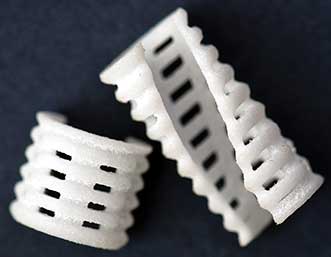Advances in processing, lower costs and improved performance could soon move 3D printing from prototyping to commercial production of aerospace and medical components.
 For additive manufacturing, aka 3D printing, 2016 could be a very good year. Some big names are entering the field, advances promise better processing and signs point to movement into the mainstream. At the same time, the industry is working on developing standards while continuing to lower cost and improve performance — thereby addressing issues that have hindered adoption of additive manufacturing.
One result looks to be explosive growth. Titanium powder is a raw 3D printing material, and its consumption is a proxy for overall additive manufacturing activity. That appears strong, based on projections for the titanium powder market over the next decade.
“That is about a 31.4 percent compound annual growth rate,” said Scott Dunham, senior analyst at SmarTech Markets, a 3D printing analysis firm.
SmarTech Markets forecasts the titanium powder market will grow from $66 million worldwide in 2015 to $776 million by 2024. Titanium is favored in aerospace and medical applications, two areas willing to pay a premium to produce high-performing critical parts. This may be for orthopedic implants, aircraft support structures and engine components. GE, for instance, is making all-important fuel nozzles for its latest engines via additive manufacturing.
What also sets medical and aerospace apart is that both are no longer interested in prototyping alone. “In medical, they’re printing a lot of parts for actual final use in patients. In aerospace, there’s an impressive number of parts that are scheduled for actual production in the coming months,” Dunham said.
An indication of this increasing maturity can be found in what Siemens AG is doing. A diversified technology and manufacturing company, Munich-based Siemens makes, among other things, gas turbines. The company today uses additive manufacturing to create better and higher-performing burner tips for those turbines.
For additive manufacturing, aka 3D printing, 2016 could be a very good year. Some big names are entering the field, advances promise better processing and signs point to movement into the mainstream. At the same time, the industry is working on developing standards while continuing to lower cost and improve performance — thereby addressing issues that have hindered adoption of additive manufacturing.
One result looks to be explosive growth. Titanium powder is a raw 3D printing material, and its consumption is a proxy for overall additive manufacturing activity. That appears strong, based on projections for the titanium powder market over the next decade.
“That is about a 31.4 percent compound annual growth rate,” said Scott Dunham, senior analyst at SmarTech Markets, a 3D printing analysis firm.
SmarTech Markets forecasts the titanium powder market will grow from $66 million worldwide in 2015 to $776 million by 2024. Titanium is favored in aerospace and medical applications, two areas willing to pay a premium to produce high-performing critical parts. This may be for orthopedic implants, aircraft support structures and engine components. GE, for instance, is making all-important fuel nozzles for its latest engines via additive manufacturing.
What also sets medical and aerospace apart is that both are no longer interested in prototyping alone. “In medical, they’re printing a lot of parts for actual final use in patients. In aerospace, there’s an impressive number of parts that are scheduled for actual production in the coming months,” Dunham said.
An indication of this increasing maturity can be found in what Siemens AG is doing. A diversified technology and manufacturing company, Munich-based Siemens makes, among other things, gas turbines. The company today uses additive manufacturing to create better and higher-performing burner tips for those turbines.
Member Exclusive: To read the complete article, please Login or Register